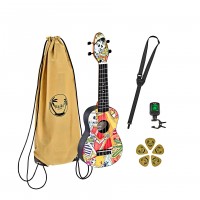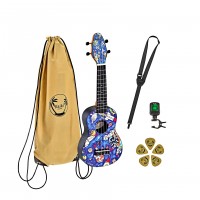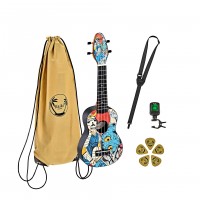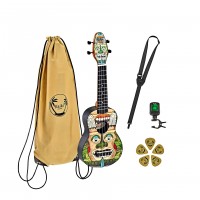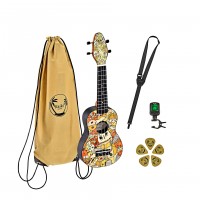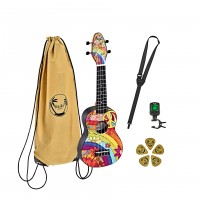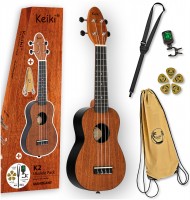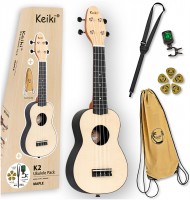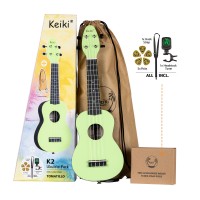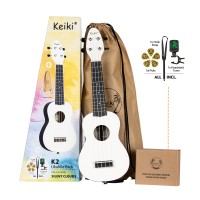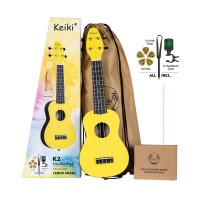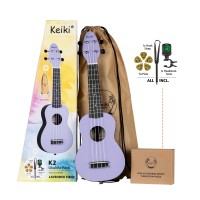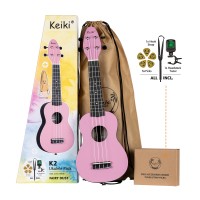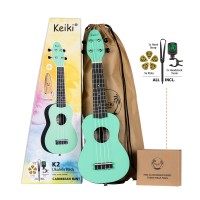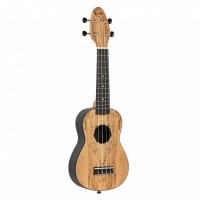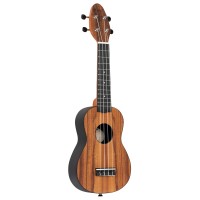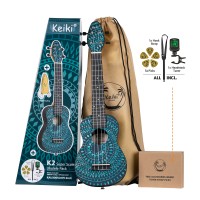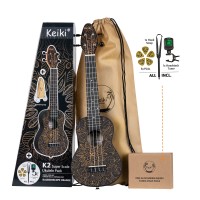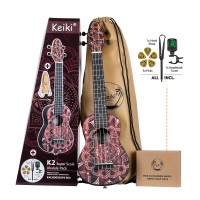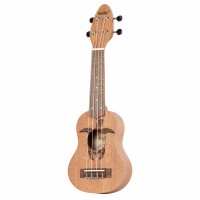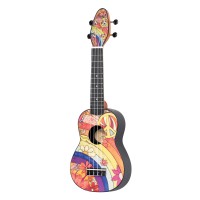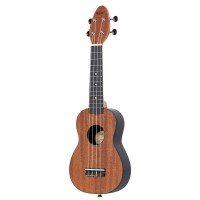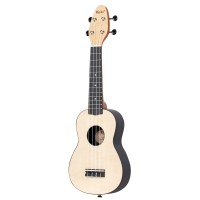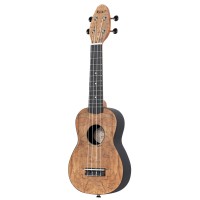FINDING THE BEST SUITABLE UKULELE
AN OVERVIEW OF THE DIFFERENT SIZES
To begin with, having a size that fits you, makes playing more comfortable and easy to stick to your new hobby. Another aspect to consider is each ukulele size has its unique sonic qualities. The timbre of smaller ukuleles is brighter, whereas the timbre of larger ukuleles has more low ends and different tuning. As a result, your sound preferences also play a role in your ukulele selection.
Here you can see all five sizes from which to choose. The distance between the nut and the saddle is known as the scale length. It is used to determine the ukulele’s size.
Ukulele sizes in ascending order from small to large:
Sopranino - Soprano - Concert - Tenor - Baritone (True to scale)
The five ukulele sizes
Sopranino
The tone of the Sopranino Ukulele is particularly bright. This ukulele is the tiniest and lightest of all the ukuleles. It features 12 frets, which are closer together than the frets on the Soprano, Concert, Tenor, and Baritone Ukuleles. As a result, it's great for children and younger musicians.
The standard tuning for Sopranino Ukuleles is: A D F# B
Sopranino, as well as Soprano ukuleles from Ortega Guitars are sold under the brand KEIKI®. You can also find them in Meinlshop:
Soprano
The Soprano Ukulele produces a traditional ukulele sound. Its bright tone is immediately associated with Hawaii and white sandy beaches. Among the ukuleles, this one is the second smallest size. It also features 12 frets, which are closer together than the frets on the Concert, Tenor and Baritone Ukuleles. This makes it ideal for young and inexperienced musicians and players with small hands.
The standard tuning for Soprano Ukuleles is: G C E A
In Meinlshop we offer you two series of Soprano Ukuleles from Ortega Guitars. These are the KEIKI K2 Ukulele Sets "Horror vacui" and the KEIKI K3 series.
Concert
Following the Soprano Ukulele in size is the Concert Ukulele. It features the classic ukulele sound, but it is more voluminous than the Soprano Ukulele due to its larger body. It has 18 frets, which are slightly wider apart than those of a Soprano Ukulele. It's ideal for musicians who require a bit more space when fretting chords.
The standard tuning for Concert Ukuleles is: G C E A
Tenor
This size is slightly larger and heavier than the concert size. This results in a rich and full tone that has more low ends than the Concert Ukulele. The Tenor Ukulele's neck is both longer and wider, resulting in a wider spacing between the 18 frets. It sounds great in the high registers, making it ideal for players who enjoy playing large intervals. This ukulele is quite popular among advanced players. However, the tenor ukulele can also be a good choice for beginners with larger hands.
The standard tuning for Tenor Ukuleles is: G C E A
(To allow for a wider range, the G-string on the tenor ukulele is frequently tuned an octave lower.)
Baritone
The Baritone Ukulele is the next size up after the Tenor Ukulele. With its powerful and bassy tone, it no longer sounds like a ukulele, but rather like an acoustic guitar. Plucking the strings is also enjoyable, thanks to a bigger neck and wider fret spacing between the 18 frets than the Concert and Tenor Ukuleles. Beginners, advanced players, and professionals can all benefit from it, especially those with big hands. Last but not least, the Baritone Ukulele is often used as a substitute for a guitar.
Its tuning is identical to that of an acoustic guitar's upper four strings: D G B E
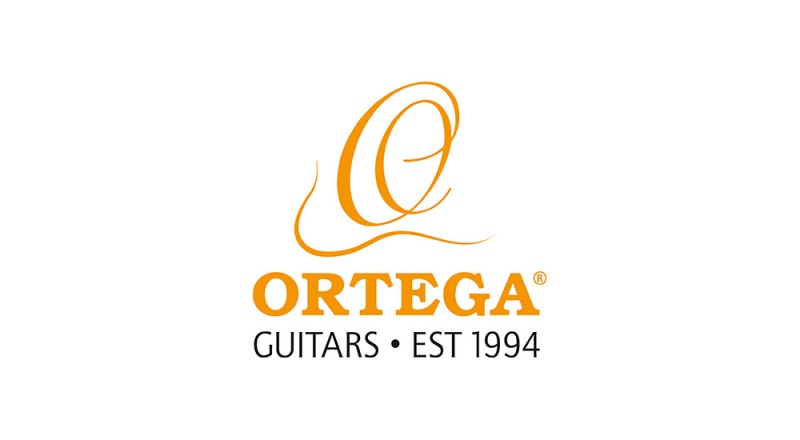
Established in 1994, Ortega Guitars introduced German design to authentic and traditional methods of guitar making. Committed to innovation and quality, Ortega strives to improve what is expected at every level of all their acoustic instruments.
Options like the 12hole bridge, often found only on high-end guitars, are standard on Ortega entry level to professional nylon string guitars. Their wide variety of body an neck sizes accomodates all ages giving everyone an opportunity to learn and play. In addition, they have released one of the widest selection of instruments specifically designed for the wide variety of left-handed players in 2020.
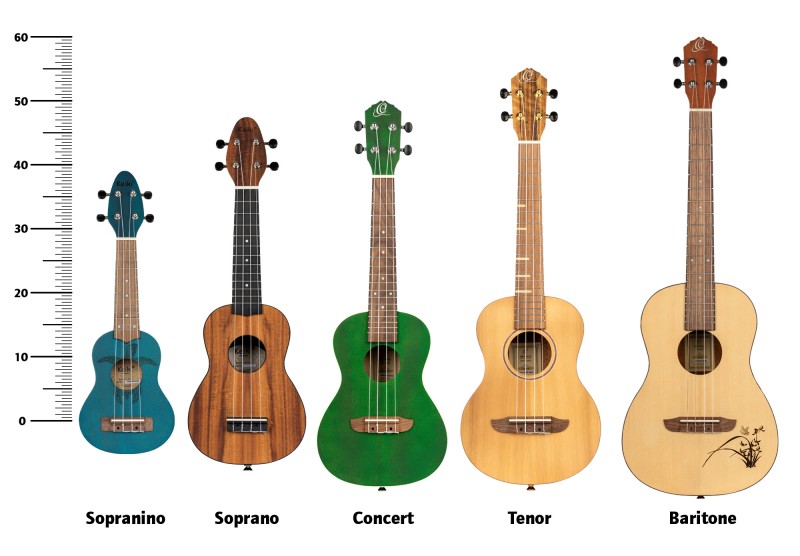
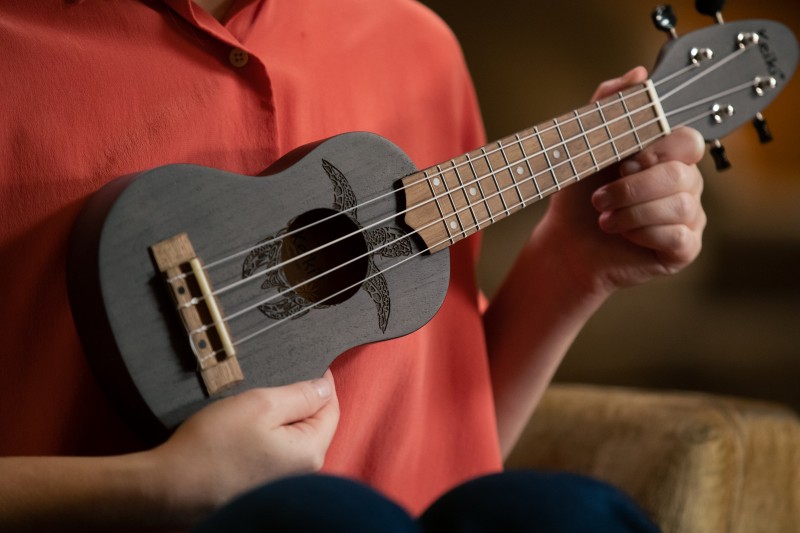
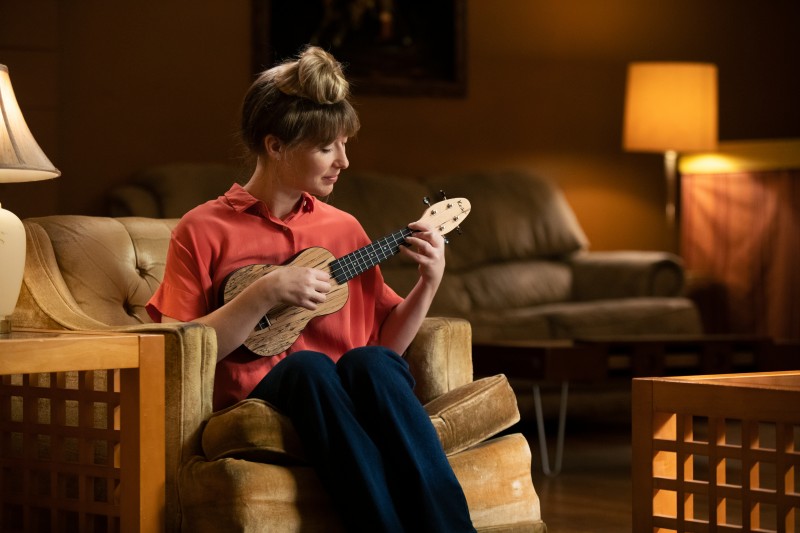
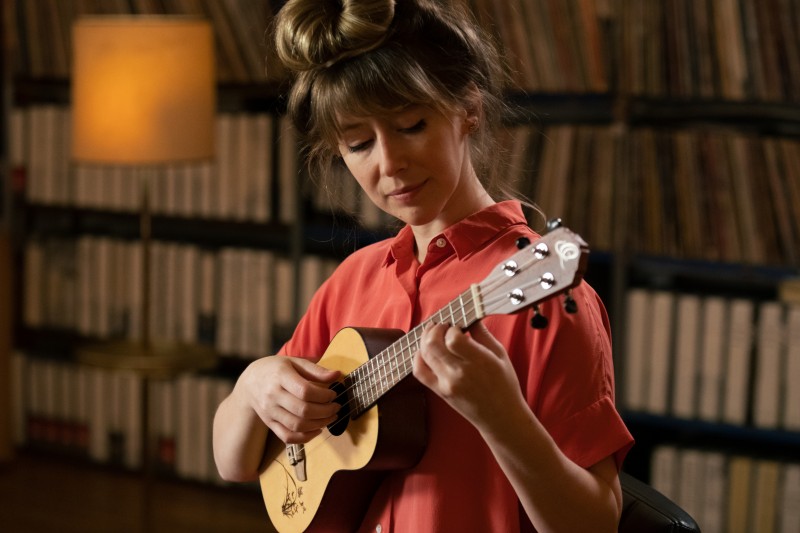
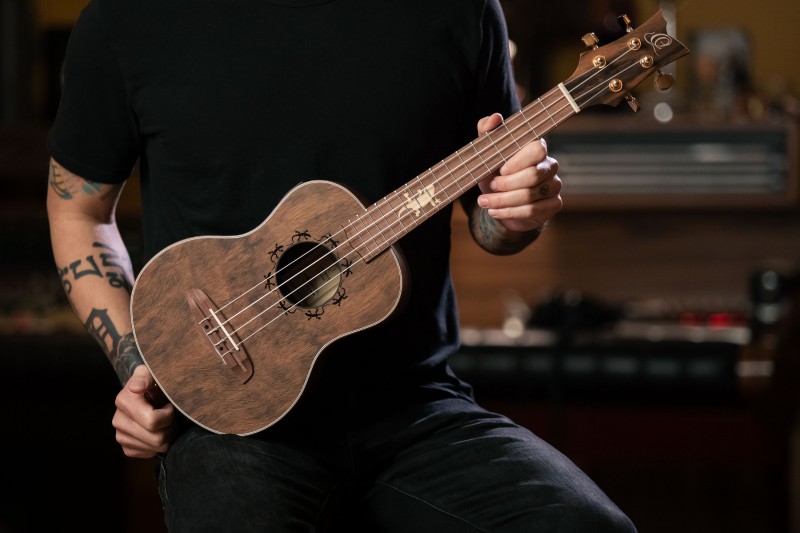
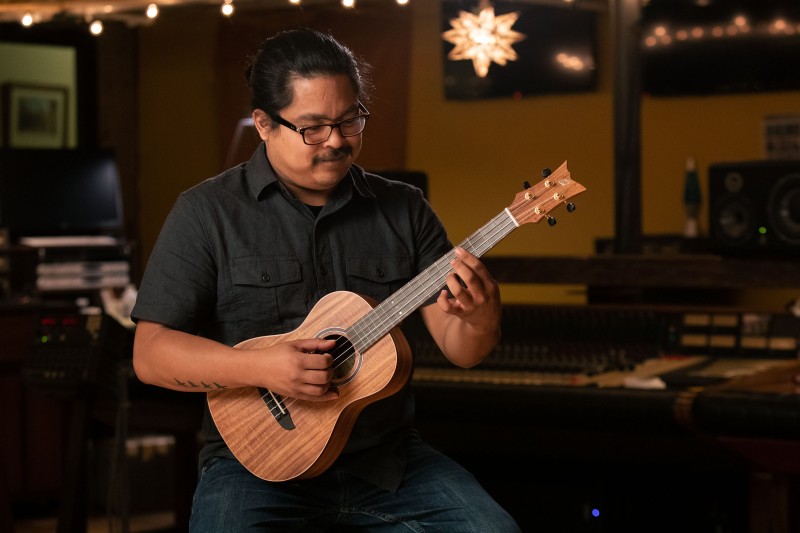
FINDING THE BEST SUITABLE UKULELE
AN OVERVIEW OF THE DIFFERENT SIZES
To begin with, having a size that fits you, makes playing more comfortable and easy to stick to your new hobby. Another aspect to consider is each ukulele size has its unique sonic qualities. The timbre of smaller ukuleles is brighter, whereas the timbre of larger ukuleles has more low ends and different tuning. As a result, your sound preferences also play a role in your ukulele selection.
Here you can see all five sizes from which to choose. The distance between the nut and the saddle is known as the scale length. It is used to determine the ukulele’s size.
Ukulele sizes in ascending order from small to large:
Sopranino - Soprano - Concert - Tenor - Baritone (True to scale)
The five ukulele sizes
Sopranino
The tone of the Sopranino Ukulele is particularly bright. This ukulele is the tiniest and lightest of all the ukuleles. It features 12 frets, which are closer together than the frets on the Soprano, Concert, Tenor and Baritone Ukuleles. As a result, it's great for children and younger musicians.
The standard tuning for Sopranino Ukuleles is: A D F# B
Sopranino, as well as Soprano Ukuleles from Ortega Guitars are sold under the brand KEIKI®. You can also find them in Meinlshop:
Soprano
The Soprano Ukulele produces a traditional ukulele sound. Its bright tone is immediately associated with Hawaii and white sandy beaches. Among the ukuleles, this one is the second smallest size. It also features 12 frets, which are closer together than the frets on the Concert, Tenor and Baritone Ukuleles. This makes it ideal for young and inexperienced musicians and players with small hands.
The standard tuning for Soprano Ukuleles is: G C E A
In Meinlshop we offer you two series of Soprano Ukuleles from Ortega Guitars. These are the KEIKI K2 Ukulele Sets "Horror vacui" and the KEIKI K3 series.
Concert
Following the Soprano Ukulele in size is the Concert Ukulele. It features the classic ukulele sound, but it is more voluminous than the Soprano Ukulele due to its larger body. It has 18 frets, which are slightly wider apart than those of a Soprano Ukulele. It's ideal for musicians who require a bit more space when fretting chords.
The standard tuning for Concert Ukuleles is: G C E A
Tenor
This size is slightly larger and heavier than the concert size. This results in a rich and full tone that has more low ends than the Concert Ukulele. The Tenor Ukulele's neck is both longer and wider, resulting in a wider spacing between the 18 frets. It sounds great in the high registers, making it ideal for players who enjoy playing large intervals. This ukulele is quite popular among advanced players. However, the tenor ukulele can also be a good choice for beginners with larger hands.
The standard tuning for Tenor Ukuleles is: G C E A
(To allow for a wider range, the G-string on the tenor ukulele is frequently tuned an octave lower.)
Baritone
The Baritone Ukulele is the next size up after the Tenor Ukulele. With its powerful and bassy tone, it no longer sounds like a ukulele, but rather like an acoustic guitar. Plucking the strings is also enjoyable, thanks to a bigger neck and wider fret spacing between the 18 frets than the Concert and Tenor Ukuleles. Beginners, advanced players, and professionals can all benefit from it, especially those with big hands. Last but not least, the baritone ukulele is often used as a substitute for a guitar.
Its tuning is identical to that of an acoustic guitar's upper four strings: D G B E

Established in 1994, Ortega Guitars introduced German design to authentic and traditional methods of guitar making. Committed to innovation and quality, Ortega strives to improve what is expected at every level of all their acoustic instruments.
Options like the 12hole bridge, often found only on high-end guitars, are standard on Ortega entry level to professional nylon string guitars. Their wide variety of body an neck sizes accomodates all ages giving everyone an opportunity to learn and play. In addition, they have released one of the widest selection of instruments specifically designed for the wide variety of left-handed players in 2020.







